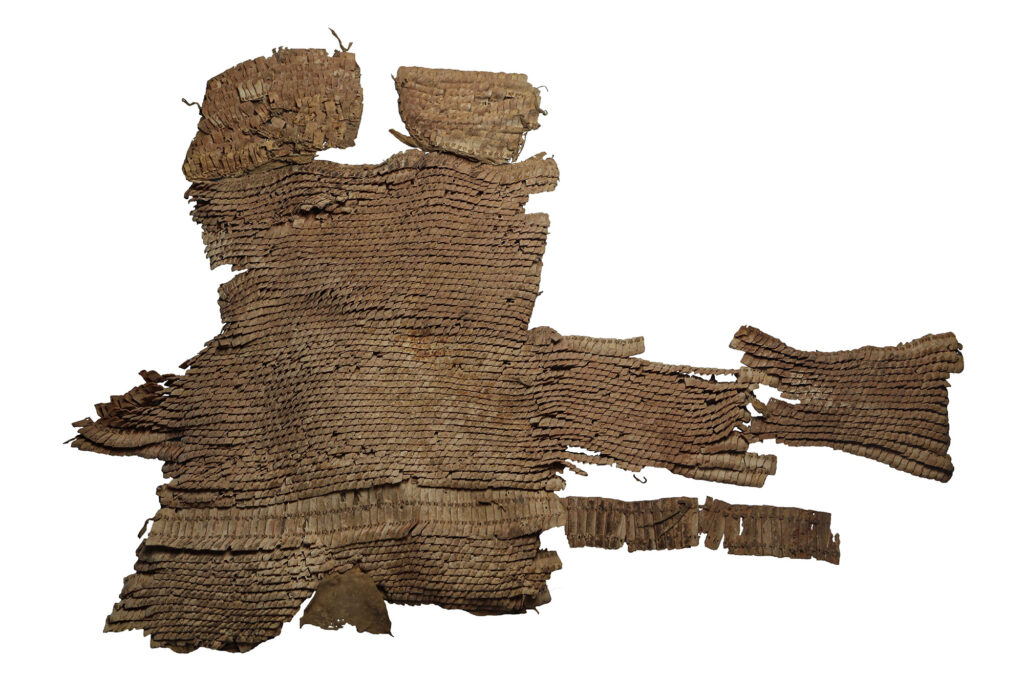Experts Find That After Worlds First Super Power Developed Hi Tech Armour 2700 Years Ago A Version Appeared In China
Swiss experts have found evidence that no sooner had the world’s first superpower developed weapons in the form of an ultra-light, easy to wear armour, than a version of it ended up in China.
The claim was made by researchers at the University of Zurich after studying a 2,700-year-old hi-tech piece of armour found in China which they said originated in the Middle East, and which they said proves that technology transfers took place in antiquity.
The team have been studying the unique leather scale armour, believed to have been made in the Neo-Assyrian Empire between the 6th and 8th Centuries BC, but that was retrieved from the tomb of a horseman in north-western China.

The University of Zurich said in a statement obtained by Newsflash that the design and construction details of the armour allowed the experts to estimate that it was made about 2,700 years ago in the Neo-Assyrian Empire.
The Neo-Assyrian Empire (in existence from about 900 to 600 BC) was the largest empire in the world at the time and they were the first to use iron weapons.
The nearly complete leather scale armour was unearthed in the tomb of a man who is thought to have been about 30 years old, near what is now the city of Turfan, in the Xinjiang region (officially the Xinjiang Uygur Autonomous Region) in north-western China, in 2013.
The university said: “This unprecedented find, which survived the millennia thanks to the area’s extremely arid climate, provided the international team led by Patrick Wertmann from the Institute of Asian and Oriental Studies of the University of Zurich with new insights on the spread of military technology during the first millennium BCE.”
They explained that scale armour was useful for protecting the user’s organs “like an extra layer of skin” but without restricting the user’s mobility.
This type of armour was typically made using small, “shield-shaped” plates arranged in horizontal rows that were then sewn onto a backing.
Armour was very expensive and precious because of the cost of the materials and the difficult manufacturing process, the university said, adding that only the elites would have had the privilege of wearing any.
It was rare for the armour to be buried with its owner but “the emergence of powerful states with large armies in the ancient world led to the development of less precious but nevertheless effective armors made of leather, bronze or iron for ordinary soldiers.”
The experts used radiocarbon dating to analyse the armour’s age and found that it dates back to between 786 and 543 BC. They said that it was originally made of about 5,444 individual scales and 140 larger scales.
They said that in total, when the leather laces and lining of the armour counted, it weighed between 4 and 5 kilogrammes (8.8 and 11 lbs).
The armour appears to have been very easy to use as it could be put on without the help of another person and could fit people of different sizes.
Patrick Wertmann said: “The armour was professionally produced in large numbers.”
With the increased use of chariots in warfare among the ancient powers of the Middle Eastern, a “special armour for horsemen was developed from the 9th century BCE”.
This kind of armour later became standard equipment for the Neo-Assyrian Empire’s military, which had a presence that extended from “parts of present-day Iraq to Iran, Syria, Turkey and Egypt.”
The university said that there was no other armour like it in all of north-western China but that it was similar to another set of armour, saying: “While there is no direct parallel to the 2,700-year-old armor in the whole of Northwest China, there are some stylistic and functional similarities to a second contemporary armour of unknown origin held by the Metropolitan Museum of Art in New York (the Met).
“It is possible that the two armours were intended as outfits for distinct units of the same army, i.e. the Yanghai armour for cavalry and the armour in the Met for infantry.
“It is unclear whether the Yanghai armour belonged to a foreign soldier working for the Assyrian forces who brought it back home with him, or whether the armour was captured from someone else who had been to the region.”
Wertmann said: “Even though we can’t trace the exact path of the scale armour from Assyria to Northwest China, the find is one of the rare actual proofs of West-East technology transfer across the Eurasian continent during the early first millennium BCE.”
The research has been published in the academic journal Quaternary International under the title “No borders for innovations: A ca. 2700-year-old Assyrian-style leather scale armour in Northwest China.”



